Nanjing: In the city of Xuzhou, located in east China’s Jiangsu Province, a biomass power plant is turning agricultural waste into clean electricity. Using massive mechanical claws to feed dried straw into furnaces, the plant processes about 300,000 tonnes of crop residues—including wheat, corn, and rice straw—each year, generating over 220 million kilowatt-hours of power, reports English.News.cn.
“That’s equivalent to saving about 90,000 tonnes of coal and reducing around 200,000 tonnes of carbon dioxide emissions annually,” said Zhang Yunfei, director of the dispatch center at State Grid Xuzhou Power Supply Company.
Biomass energy, once considered waste, is now a crucial part of China’s clean energy shift. Derived from agricultural and forestry by-products, livestock manure, and organic waste, it is emerging as a sustainable alternative to fossil fuels. With improved awareness and advanced technologies, more farmers are now transporting straw to power plants instead of burning it in fields, which previously posed fire risks and air pollution threats.
“Xuzhou has rich biomass resources and huge potential for energy conversion,” Zhang said. The city currently operates 17 large-scale biomass power plants with a combined capacity of 335.6 megawatts, generating nearly 2 billion kilowatt-hours of electricity annually.
China, one of the world’s most biomass-rich countries, generates about 3.5 billion tonnes of agricultural, forestry, and household biomass annually. However, only a small portion is currently used for energy.
In January, China enacted its first national energy law, encouraging the regional development of biomass power. In line with this policy, cities like Shanghai are piloting projects to convert biomass into green methanol for use in shipping. By 2030, Shanghai aims to build a green fuel supply capacity of 300,000 tonnes.
Elsewhere, in Anhui Province, companies are expanding initiatives in biogas liquefaction and carbon capture, turning crop waste and livestock manure into liquefied bio-natural gas.
In Suzhou, Jiangsu Province, a circular economy industrial park processes around 500 tonnes of kitchen waste daily. “Nearly 90% of it is recycled into biomass gas or nutrient-rich soil,” said Huang Yuanchen, general manager of a local environmental company. The firm also recycles up to 100 tonnes of green waste daily, turning it into fuel pellets that bring in annual sales of up to 9 million yuan (about $1.26 million USD).
Yu Tong, president of the China Association for the Promotion of Industrial Development, highlighted biomass energy’s unique advantages. “It is versatile—solid, liquid, or gas—and can replace fossil fuels across many sectors,” he said.
According to a 2025 industry report, China’s installed biomass power capacity reached nearly 46 million kilowatts by the end of 2024, generating over 208 billion kilowatt-hours of electricity and producing 500 million cubic meters of biogas.
To improve efficiency, China is deploying centralized control systems to monitor biomass plant operations in real time, enhancing both output and reliability.
Yang Xudong, a professor at Tsinghua University, emphasized biomass energy’s dual benefits. “It is not only carbon-neutral but also economically viable,” he noted. “In the future, efforts should focus on optimizing the entire biomass value chain to fully unlock its green potential.”















